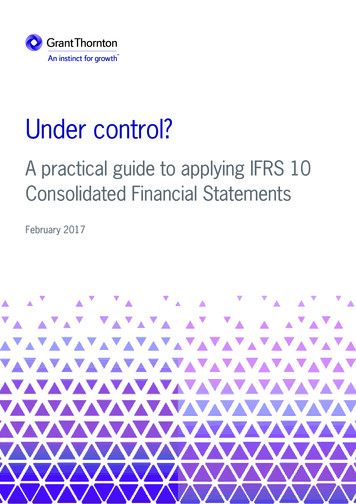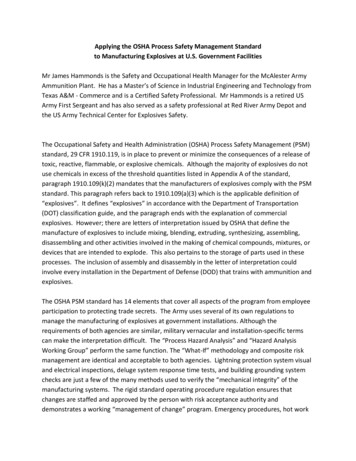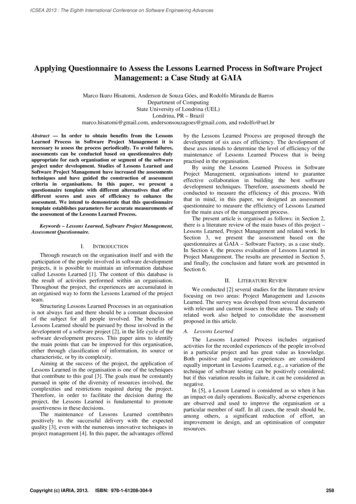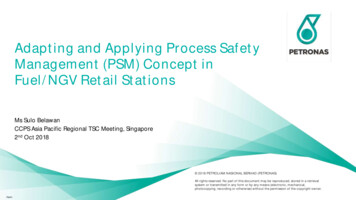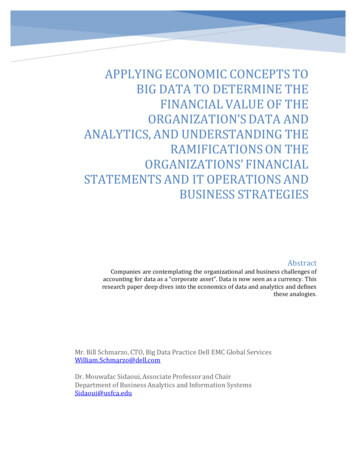
Transcription
APPLYING ECONOMIC CONCEPTS TOBIG DATA TO DETERMINE THEFINANCIAL VALUE OF THEORGANIZATION’S DATA ANDANALYTICS, AND UNDERSTANDING THERAMIFICATIONS ON THEORGANIZATIONS’ FINANCIALSTATEMENTS AND IT OPERATIONS ANDBUSINESS STRATEGIESAbstractCompanies are contemplating the organizational and business challenges ofaccounting for data as a “corporate asset”. Data is now seen as a currency. Thisresearch paper deep dives into the economics of data and analytics and definesthese analogies.Mr. Bill Schmarzo, CTO, Big Data Practice Dell EMC Global ServicesWilliam.Schmarzo@dell.comDr. Mouwafac Sidaoui, Associate Professor and ChairDepartment of Business Analytics and Information SystemsSidaoui@usfca.edu
Purpose of this Research PaperThe volume, variety and velocity of data may have changed over the past few years, but onething hasn’t changed – the value of the data to improve operational decision-making and powerbusiness strategies. This research paper will explore the following questions with respect to howdo organizations maximize the economic and financial value of the organization’s data andanalytics: How does an organization identify and prioritize the business use cases upon which tofocus its data and analytics initiatives?How does an organization determine the economic value of the data that supports theorganization’s business use cases?How does an organization create a framework that facilitates the capture and re-use ofthe organization’s data and analytic assets?What is the role of the data lake, data governance, data quality and other datamanagement disciplines in managing, protecting and enhancing the organization’s dataand analytic assets?AbstractThe importance of data has changed over the years. Initially, data was just the “exhaust” froman organization’s On-Line Transactional Process (OLTP) systems. However as the volume, varietyand velocity of the data grew over the past few years, the economic value of data has beentransformed by the big data phenomena [ci ta tion 1] that has enabled organizations to capture abroader, more granular and more real-time range of customer, product, operational and marketinteractions. Today, business leaders see data as a monetization opportunity, and theirorganizations are embracing data and analytics as the intellectual capital of the modernorganization.More and more companies are also contemplating the organizational and business challenges ofaccounting for data as a “corporate asset”. Data as an asset exhibits unusual characteristicswhen compared to other balance sheet assets (where asset is defined as property owned by aperson or company, regarded as having value and available to meet debts, commitments, orlegacies). Most assets depreciate with usage, however data appreciates or gains more valuewith usage; that is, the more the organization uses the data across more use cases, the morevaluable, complete and accurate the data becomes. These same characteristics apply toanalytics, where analytics is basically “data” that has been refined or “curated” into customer,product or operational insights.This research paper will explore data as a form of currency. Most currencies are constrained toa one-to-one transactional relationship. For example, the economic value of a dollar isconsidered to be finite – the dollar can only be used to buy one item or service at a time. Samewith the finite nature of a person as a person can only do one job at a time. However theeconomic value of data is not constrained by transactional limitations. Data as a currencyexhibits a network (or multiplier) effect, where the same data can be used simultaneously acrossmultiple business use cases thereby increasing its financial and economic value to theorganization.1
However, there are severe limitations in valuing data in the traditional balance sheetframework. It is important that firms identify a way to account for their data. Organization’s alsoneed a framework to address the “Rubik’s Cube” intellectual capital [ci ta tion 2] challenge regardinghow to identify, align and prioritize the organization’s data and analytic investments. To addressthis challenge, this research paper will put forth the following:1. A framework to facilitate the capture, refinement and sharing of the organization’s data andanalytic assets, and2. A process to help organizations prioritize where to invest their precious data and analyticresources.It is our hope that this research paper will foster new ways for organizations to re-think howthey value their data and analytics from an economic and financial perspective. The conceptscovered in this research paper will provide a common vocabulary and approach that enablesbusiness leadership to collaborate with the IT and Data Science organizations on identifying andprioritizing the organization’s investments in data and analytics; to create a commoncollaborative value creation platform.Section 1: Back to BasicsWhat is Data?Data is a valuable commodity. Data is being produced at an ever-increasing rate. IBM researchclaims greater than 2.5 quintillion bytes of data is being generated every day and that by 2020there will be over 44 trillion gigabytes of data available [ci ta tion 3]. Matt Aslett, Research Directorfor Data Platforms and Analytics Channel at 451 Research, predicts the total data marketconsisting of data platforms, database management and data analytics will double in size by2019 [ci ta tion 4]. Big data and analytics are becoming a key differentiator for the banking and thefinancial services (BFSI) industry with nearly 71% firms using data and analytics for competitiveadvantage [ci ta tion 5]. The financial services sector is projected to grow their global big dataspending at a CAGR of 25.5% over the period of 2014-2019 [ci tation 6]. A report from PWC alsosuggests that financial institutions are recognizing the power and influence of big data andanalytics on their businesses. With 2.5 quintillion bytes of data generating daily, 62% of thefinancial services companies believe data is the source of a competitive edge [ci tation 7]. Moreover,companies are finding new ways to create and acquire consumer-generated content (CGC) viasocial media platforms. Facebook is generating 33 billion CGC per month, Twitter generating 15billion CGC per month, and the content marketing player BazaarVoice generating 700 million ofCGC per month [ci ta tion 8].Data sources are not limited to only structured or relational databases. Data sources includeweb clickstreams, mobile data, blogs, news feeds and RSS feeds. Data sources includediscussions in boardrooms, networking at conferences, events and symposiums, and evenobservations of a valet at a casino.There is also a growing wealth of publicly available data such as traffic, weather, buildingpermits, home values, local events, clinical studies, research grants, patent filings, economicreports, zip code demographics, job histories, job openings, college donations, state and citybudgets, and crime reports.2
Finally the Internet of Things (IoT) will unleash a tidal wave of machine-generated data. Forexample the iBeacon technology has the potential to dramatically expand the data capturedduring a customer’s in-store retail experience. This technology allows smartphones toseamlessly interact with the physical sensors present in the store running on Bluetooth LowEnergy (BLE) to determine your precise location – to determine which department you are inand at what products are you looking. Combining this data with your purchase data will enableretailers to design highly personalized loyalty programs and marketing campaigns.Even though data is not a physical entity, data plays a critical role in determining anorganization’s financial valuation.What is Analytics?Analytics is defined as the systematic computational analysis of data. Analytics mine thegrowing wealth of internal and publicly available data to quantify operational and behavioralinsights that can be used to improve the effectiveness and efficiency of the organization’sdecisions; decisions ranging from predicting store sales to predicting a sports team’s efficiencybased upon on-field player movements.Analytics is the basis for fact-based decision making. A focus on optimizing decisions is critical tobusiness success. According to a study by MIT Center of Digital Business [ci tation 9], organizationsdriven by data-driven decisions had a 4% higher productivity and a 6% higher profitability.Analytics encompasses a growing field of data science capabilities including statistics,mathematics, machine learning, predictive modeling, data mining, cognitive computing andartificial intelligence.There are four categories of analytics that organizations need to consider: Descriptive: monitoring current state performance or results Diagnostic: understanding (quantifying) drivers of performances Predictive: forecasting likely outcomes Prescriptive: recommending actions for future decisionsBig Data Intellectual Capital “Rubik’s Cube” ChallengeThomas A Stewart, the Executive Director of National Center for the Middle Market (NCMM)stated that intelligence becomes an asset only when it is productive and creates somethinguseful. Organizations need a focal point that helps them to align and coordinate theorganization’s data and analytics to create something that is productive and creates somethinguseful. Business use cases are that focal point and drive the alignment, coordination andoptimization of the organization’s data and analytic assets.Business use cases are clusters of decisions around a common subject area. For example, acustomer retention business use case would make decisions such as which customers areconsidered at-risk, which customers are worthy of retention efforts, which retention offers aremost appropriate for which customers, what channels are the most appropriate for whichcustomers, what relationships could be leveraged to enforce the messaging, when and how tofollow up to those offers, etc.Use cases, combined with data and analytics, form the three dimensions of the “Big DataIntellectual Capital Rubik’s Cube” solution”. Identifying, prioritizing and quantifying the business3
use cases are key to effectively aligning and coordinating the organization’s data and analyticassets and corresponding financial and human investments. If not aligned to the organization’skey business use cases, then organizations may end up with missing or misaligned data, andineffective or orphaned analytics that yield suboptimal (or even the wrong) business outcomes.Data and Analytics: Building Competitive DifferentiationData plays a pivotal role in defining competitive differentiation. But organizations need tounderstand where to invest their scarce data and analytic resources to drive competitivedifferentiation; organizations need to understand when to buy for competitive parity and whento build for competitive differentiation. For example, it is likely best to buy enterprise softwarepackages – such as Enterprise Resource Planning (ERP), Customer Relation Management (CRM),Human Resources (HRMS), Sales Force Automation (SFA), Supply Chain Management (SCM) andMarketing Automation (MA) – that provide competitive parity. There is little businessdifferentiation when all organizations are running the same enterprise software.However, leading companies are realizing that they can exploit data and analytics to buildbusiness differentiation such as optimizing key business processes, reducing security andcompliance risk, uncovering new monetization opportunities and creating a more compellingcustomer and partner engagement. Examples of companies that are leveraging data andanalytics to create competitive differentiation include: Google: PageRank and Ad Serving Yahoo: Behavioral Targeting and Retargeting Facebook: Ad Serving and News Feed Apple: iTunes Recommendations Netflix: Movie Recommendations Amazon: “Customers Who Bought This Item”, 1-Click ordering and Supply Chain &Logistics Walmart: Demand Forecasting, Supply Chain Logistics and Retail Link Procter & Gamble: Brand and Category Management Federal Express Critical Inventory Logistics American Express and Visa: Fraud Detection GE: Asset Optimization and Operations Optimization (Predix )Digital-first companies such as Google, Netflix, Facebook, and Amazon understand how toexploit their data and analytics to power business success. These organizations also understandhow to account for the value of data and analytics on their financial statements. For example,when Facebook launched its 2012 IPO, it highlighted the financial value of data on thecompany’s balance sheet. A unique user was worth 4 to Facebook and the aggregated value ofthe data that the company collected on each unique user was valued on Facebook’s balancesheet at nearly 6.6 billion [ci ta tion 10].Many organizations have started recognizing the need to account for the value of their data.According to a study by SAS in January 2016, nearly 20% of the large firms in the UK have startedaccounting for the value of their data. With the advent of Internet of Things, they estimated thetotal value of data and analytics from 2015 to 2020 to be nearly 322 Billion. In addition, theyestimate the equivalent benefit of the data and the Internet of Things to be around 46 Billion,approximately 2.1% of their GDP [ci ta tion 11]. In another example, AT&T in 2011 accounted fortheir customer relationships at nearly 2.7 billion on their balance sheet [ci ta tion 12].The economic value of data and analytics is also becoming an important consideration duringmergers. Neilson Holdings quoted “customer-related intangibles” worth 271 million on their4
balance sheet post acquisition of the radio audience tracker Arbitron Inc. [ci ta tion 13]. When itcomes to the economic valuation of data, the numbers are staggering. McKinsey Globalinstitutes estimates the potential economic valuation of data at nearly 3 trillion, while theWarsar Institute of Economics projects it to be 205 billion annually to the European Union[ci ta tion 14].Section 2: Economics 101To help organizations properly account for the value of their data and analytics, organizationsneed to understand some basic economic concepts. Let’s start the conversation with adefinition:Data Economics: The science of human choice and behaviors with respect to the production,distribution and consumption of scare data and analytic resources.Economic concepts are built around the law of supply and demand. The law of supply anddemand rationalizes the interaction between the supply of a resource and the demand for thatresource, and the subsequent effect that the law of supply and demand has on price.There are other basic economic concepts that can be applied to help organization’s prioritize theproduction, distribution and consumption of the organization’s scarce data and analyticresources. Let’s review these economic concepts and see how they could impact the economicvalue of an organization’s data and analytic assets.ScarcityScarcity refers to limitations; insufficient resources, goods, or capabilities to achieve the desiredends. Figuring out ways to make the best use of scarce resources or find alternatives isfundamental to economics [ci tation 15].Scarcity is the heart of the economics discussion and ties directly to the law of supply anddemand. Organizations have a limited pool of human and financial resources to fulfill selecttasks. By the same token, organizations have a limited pool of data and analytic resources.Consequently, organizations need to factor scarcity into their decisions by prioritizing their dataand analytic resources against the most appropriate business use cases.To address the data and analytics scarcity issue, organizations need to acquire and/or developadditional analytic capabilities. This includes hiring additional data science resources, expandingthe training of existing business analysts, hiring analytic consultants, and acquiring analytic toolsand methodologies. But even with the acquisition of additional analytic resources, there willalways be more demand than supply. How the organization prioritizes their analytic resourcesagainst an ever-increasing demand will be pivotal in determining organizational success orfailure.Postponement TheoryPostponement is a decision to postpone a decision. Postponement can occur as one party seeksto either gain additional information about the decision or to delay the decision seeking betterterms from the other party.Postponement theory is a factor if postponement is due to “insufficient” data from which todraw insights to improve the probability of making a “better” decision. Also, the critical natureof the decision – and the associated Type I and Type II risks and costs – also plays an importantfactor in making a postponement decision.5
In order to facilitate a postponement decision, organizations need to understand the followingdata and analytic factors: What is the estimated effectiveness of the current decision? What data might be needed to improve the effectiveness of that decision? How much more accurate can the decision be made given these new data sources andadditional data science time? What is the cost of the data versus the projected financial return from improvement indecision effectiveness? What are the risks and liabilities associated with Type I/Type II errors (i.e., costs associatedwith making the wrong decision)? See “Understanding Type I and Type II Errors” for moredetails on Type I/Type II errors.EfficiencyEfficiency is a relationship between ends and means. When we call a situation inefficient, we arestating that we could achieve the desired ends with less means, or that the means employedcould produce more of the ends desired.To improve operational efficiency, organizations need to first create metrics against which tomeasure the effectiveness of that operational process. With the ability to measure currentperformance, operational discrepancies can be flagged, analyzed to understand (quantify) thevariables that cause the discrepancy (predictive analytics) and then create recommendedactions (prescriptive analytics).Also, the aggregation of the operational insights (i.e., customer usage behaviors and productperformance patterns aggregated across all customer and business constituents) gained fromefficiency improvement can lead to new monetization opportunities. For example,organizations could create benchmark, share, and index calculations that their customers andpartners could use to measure their own efficiencies vis-à-vis others. Organizations couldcapture the best practices across their aggregated customers and partners in order to providerecommendations on how those customers and partners could improve operational efficiencies.Economic MultiplierEconomic Multiplier is defined as an economic effect where an increase in spending produces anincrease in national income and consumption greater than the initial amount. The multiplier isthus, a ratio of change in income over investment [citation 16]:k Y/ IWhere:k the economic multiplier Y change in income I change in investmentThe Multiplier Effect was developed by J.M. Keynes to explain the relationship betweeninvestments and outcomes in an economy. The essence of the multiplier is that the totalincrease in outcomes (e.g., income, gross national product, employment) is greater (ormultiplies) the original increase in investment. The multiplier effect emphasizes how6
investments in acquiring new data and developing new analytics algorithms can drive amagnitude increase in economic value of the organizations data and analytics.For example, in the early 1980s, Consumer Packaged Goods (CPG) Manufacturers such asProcter & Gamble, Kraft, Unilever and General Mills drove their marketing strategies based onthe Neilson bi-monthly audit data (6 observations per year per market). However with theadvent of Po
Big data and analytics are becoming a key differentiator for the banking and the financial services (BFSI) industry with nearly 71% firms using data and analytics for competitive advantage [citation 5]. The financial services sector is projected to grow their global big data spending at a C






